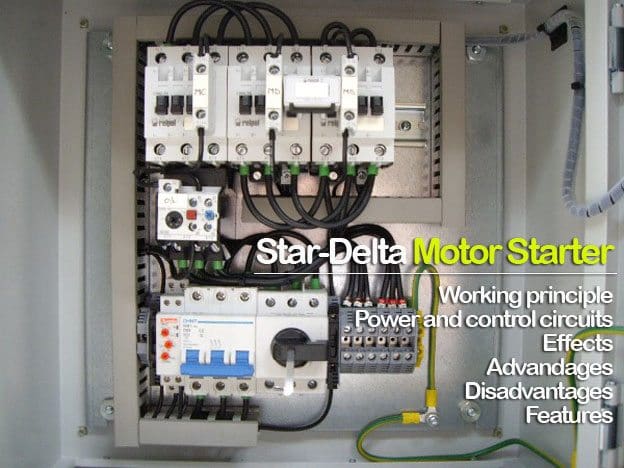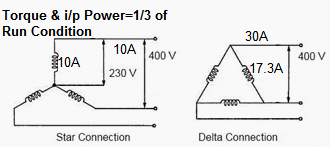
Introduction to Star-Delta motor starter

Most induction motors are started directly on line, but when very large motors are started that way, they cause a disturbance of voltage on the supply lines due to large starting current surges. To limit the starting current surge, large induction motors are started at reduced voltage and then have full supply voltage reconnected when they run up to near rotated speed.
Two methods used for reduction of starting voltage are: Star delta starting and Auto transformer starting.
Working Principle of Star-Delta Starter

After a period of time the winding are reconfigured as delta and the motor runs normally. Star/Delta starters are probably the most common reduced voltage starters. They are used in an attempt to reduce the start current applied to the motor during start as a means of reducing the disturbances and interference on the electrical supply.
Traditionally
in many supply regions, there has been a requirement to fit a reduced
voltage starter on all motors greater than 5HP (4KW). The Star/Delta (or
Wye/Delta) starter is one of the lowest cost electromechanical reduced
voltage starters that can be applied.
The Star/Delta starter is
manufactured from three contactors, a timer and a thermal overload. The
contactors are smaller than the single contactor used in a Direct on
Line starter as they are controlling winding currents only. The currents
through the winding are 1/root 3 (58%) of the current in the line.There are two contactors that are close during run, often referred to as the main contractor and the delta contactor. These are AC3 rated at 58% of the current rating of the motor. The third contactor is the star contactor and that only carries star current while the motor is connected in star.
The current in star is one third of the current in delta, so this contactor can be AC3 rated at one third (33%) of the motor rating.
Star-delta Starter Consists following units
- Contactors (Main, star and delta contactors) 3 No’s (For Open State Starter) or 4 No’s (Close Transient Starter).
- Time relay (pull-in delayed) 1 No.
- Three-pole thermal overcurrent release 1 No.
- Fuse elements or automatic cut-outs for the main circuit 3 Nos.
- Fuse element or automatic cut-out for the control circuit 1No.
Power Circuit of Star Delta Starter
The main circuit breaker serves as the main power supply switch that supplies electricity to the power circuit.The main contactor connects the reference source voltage R, Y, B to the primary terminal of the motor U1, V1, W1.
In operation, the Main Contactor (KM3) and the Star Contactor (KM1) are closed initially, and then after a period of time, the star contactor is opened, and then the delta contactor (KM2) is closed. The control of the contactors is by the timer (K1T) built into the starter. The Star and Delta are electrically interlocked and preferably mechanically interlocked as well.
 The ON push button starts the circuit by initially
energizing Star Contactor Coil (KM1) of star circuit and Timer Coil (KT)
circuit. When Star Contactor Coil (KM1) energized, Star Main and
Auxiliary contactor change its position from NO to NC.
The ON push button starts the circuit by initially
energizing Star Contactor Coil (KM1) of star circuit and Timer Coil (KT)
circuit. When Star Contactor Coil (KM1) energized, Star Main and
Auxiliary contactor change its position from NO to NC.When Star Auxiliary Contactor (1) (which is placed on Main Contactor coil circuit ) become NO to NC it’s complete The Circuit of Main contactor Coil (KM3) so Main Contactor Coil energized and Main Contactor’s Main and Auxiliary Contactor Change its Position from NO to NC. This sequence happens in a friction of time.
After pushing the ON push button switch, the auxiliary contact of the main contactor coil (2) which is connected in parallel across the ON push button will become NO to NC, thereby providing a latch to hold the main contactor coil activated which eventually maintains the control circuit active even after releasing the ON push button switch.
When Star Main Contactor (KM1) close its connect Motor connects on STAR and it’s connected in STAR until Time Delay Auxiliary contact KT (3) become NC to NO.
Once the time delay is reached its specified Time, the timer’s auxiliary contacts (KT)(3) in Star Coil circuit will change its position from NC to NO and at the Same Time Auxiliary contactor (KT) in Delta Coil Circuit(4) change its Position from NO To NC so Delta coil energized and Delta Main Contactor becomes NO To NC. Now Motor terminal connection change from star to delta connection.
A normally close auxiliary contact from both star and delta contactors (5&6)are also placed opposite of both star and delta contactor coils, these interlock contacts serves as safety switches to prevent simultaneous activation of both star and delta contactor coils, so that one cannot be activated without the other deactivated first. Thus, the delta contactor coil cannot be active when the star contactor coil is active, and similarly, the star contactor coil cannot also be active while the delta contactor coil is active.
In open transition there are four states:
- OFF State: All Contactors are open.
- Star State: The Main [KM3] and the Star [KM1] contactors are closed and the delta [KM2] contactor is open. The motor is connected in star and will produce one third of DOL torque at one third of DOL current.
- Open State: This type of operation is called open transition switching because there is an open state between the star state and the delta state. The Main contractor is closed and the Delta and Star contactors are open. There is voltage on one end of the motor windings, but the other end is open so no current can flow. The motor has a spinning rotor and behaves like a generator.
- Delta State: The Main and the Delta contactors are closed. The Star contactor is open. The motor is connected to full line voltage and full power and torque are available
2. Closed Transition Star/Delta Starter
There is a technique to reduce the magnitude of the switching transients. This requires the use of a fourth contactor and a set of three resistors. The resistors must be sized such that considerable current is able to flow in the motor windings while they are in circuit.The auxiliary contactor and resistors are connected across the delta contactor. In operation, just before the star contactor opens, the auxiliary contactor closes resulting in current flow via the resistors into the star connection. Once the star contactor opens, current is able to flow round through the motor windings to the supply via the resistors. These resistors are then shorted by the delta contactor.
If the resistance of the resistors is too high, they will not swamp the voltage generated by the motor and will serve no purpose.


